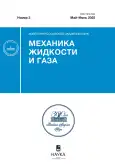Nº 3 (2025)
Articles
Numerical Analysis of Rarefied Gas Flow through a Periodic System of Channels
Resumo
 3–14
3–14


Self-Oscillations in an Axisymmetric Generator of Pulsed Jets and High-Frequency Regime Associated with Cavity Boundary Instability
Resumo
Liquid jet flows in the presence of a ventilated cavity with a negative cavitation number are investigated. The studies carried out in the Institute of Mechanics of Moscow State University show that under certain conditions cavitation-induced self-oscillations can occur in the hydraulic system with highly intense pressure fluctuations. The results of an investigation of the axisymmetric model of a pulsed jet generator with liquid jet outflow through a central orifice in a diaphragm and gas blow from the periphery beyond the diaphragm are presented. The two-phase medium outflow was realized through a convergent conical nozzle. The influence of the generator parameters and the distance to a wall (screen) on the efficiency of its operation is investigated. A narrow range of comparatively small blowing, in which high-frequency pressure oscillations are recorded, while the amplitude of impact pressure pulses on the screen is considerably higher than the amplitude of pulses in high-frequency generation regimes, is revealed. This flow regime can be due to the development of two-phase structures on the unstable jet boundary interactioning with the convergent nozzle walls. The evidence for the possible existence of this flow regime has been given by the solution of the plane problem of interaction between a finite jet and an inclined plate for different pressures on the jet surfaces. The problem was solved exactly using the methods of theory of functions of a complex variable for quasi-doubly-periodic theta functions.
 15–29
15–29


On Self-Similarity of Laminar Jets
Resumo
 30–36
30–36


Temperature Factor Effect on the Disturbance Propagation in the Flow past a Blunt Plate in the Interaction Regime
Resumo
 37–46
37–46


Extended High-Current Arc Discharges in an External Magnetic Field in Gas Media
Resumo
 47–59
47–59


Hydrodynamic Instability of Spatially Periodic Flows of Homogeneous and Stratified Fluid with Regard for Friction. Formation of Steady-State Vortex Disturbances
Resumo
 60-72
60-72


Turbulent Boundary Layer on a Plate in Compressible Gas Flow
Resumo
 73–79
73–79


Vertical Momentum Transfer by Internal Waves with Regard for the Horizontal Component of Angular Velocity of the Earth’s Rotation
Resumo
 80-93
80-93


Simulation of One-Sided Convection in a Porous Medium Using a Nonlinear Equation of State
Resumo
 94–106
94–106


The Effect of the Delta Wing Vortex System on the Flow around Lifting Surfaces
Resumo
The vortex structures formed behind a delta wing in supersonic flow are considered. The dependence of these structures on the angle of attack and the oncoming flow Mach number is studied, together with their effect on the aerodynamic properties of a downstream straight wing. The regimes with M = 2 and 3 and α = 10°, 14°, and 20° are considered. The numerical data are obtained using the hybrid multiprocessor supercomputer K-60 system in the Common Use Center of the Keldysh Institute of Applied Mathematics of the Russian Academy of Sciences.
 107–119
107–119


Comparison of Newton's Problem Solutions for Axisymmetric and Non-Axisymmetric Bodies
Resumo
 120–134
120–134


Numerical Study of Flow Structure in an Axisymmetric Channel with Injection of a Radial Jet along the Coanda Surface
Resumo
 135–146
135–146











